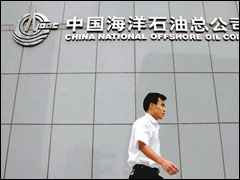Center
CNOOC sees wave of new LNG deals by 2008
(Reuters)
Updated: 2006-07-29 10:10
 |
Large Medium Small |
The deal will be the first in CNOOC's renewed drive to secure supplies for five planned import terminals by the end of next year, the senior official, who wished to remain anonymous, told Reuters.
 A man walks past CNOOC building in this undated photo. [cri.com] |
The official declined to comment on specific deals but said the firm expected to make "some announcement" in two to three months. Chinese media reported this week that CNOOC was in advanced talks with Malaysia to supply the Shanghai terminal.
The comments are among the first to suggest that Beijing is willing to face the market reality that global gas prices have raced sharply higher since China's first deal with Australia in 2002, and that its ambitious goal of boosting use of the green fuel may flop if it further stalls on supply talks.
"There were some misunderstandings about China in the market. We will operate our business in line with market rules," the CNOOC official said, in an acknowledgement of higher prices.
LNG contract prices have doubled since CNOOC's first landmark deal agreed four years ago at about $3 per million British thermal unit (BTU), analysts estimate.
With demand set to grow swiftly in a global rush to embrace a fuel that is cleaner than coal and cheaper than oil, few expect prices to ease.
CNOOC, which started up the country's first LNG terminal in southern Guangdong province last month, has plans to build another four projects in Fujian, Shanghai, Ningbo and Zhuhai, all on the east and southeastern coast, by around 2010.
A second phase of its Guangdong terminal will raise capacity by 6.2 million tonnes per year (tpy), while the other four projects would need 3 million tpy each from around 2010, officials have said.
In total, CNOOC could need to buy as much as 18 million tpy of LNG, near the imports into South Korea, the world's second-largest buyer of the super-cooled gas.
The fuel is crucial if China hopes to achieve its goal to more than doubling the share of gas in its energy mix by 2010, despite a pair of massive domestic natural gas finds this year.
Already faster-than-expected demand growth from urban users and industries in the booming coastal belt has led to supply shortages due to unprepared infrastructure and low prices.
The market dilemma CNOOC faces is shared by its domestic rivals Sinopec Corp. and PetroChina, both of which have planned a combined half dozen terminals along the northern coast in a race to kick-start the nascent LNG sector.
But with most LNG supplies through 2012 pre-sold to Japanese or Western buyers from new projects in exporters such as Australia and Qatar, China may have to seek less established suppliers with short-term availability, industry experts say, settling for five-to-10 year contracts instead of the usual 25.
Possible options may include Indonesia, which has stalled on renewing major Japanese contracts that expire in 2010, and Iran, whose entrance into the LNG market has been set back repeatedly.